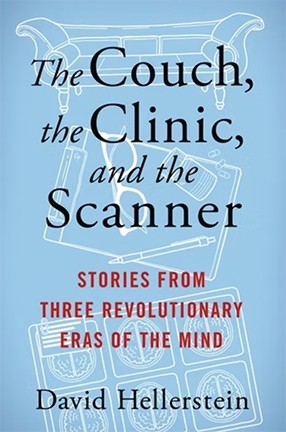A New Book Traces the Turbulent History of Psychiatry
David Hellerstein covers everything from psychoanalysis to the DSM diagnostic manual and neuroscience.

The Couch, the Clinic, and the Scanner: Stories from Three Revolutionary Eras of the Mind, the new book by David Hellerstein, a professor of clinical psychiatry at Columbia University Irving Medical Center, covers the radical changes psychiatry has undergone over the past several decades. After its midcentury heyday, psychoanalysis gave way to a worldview guided by the Diagnostic and Statistical Manual, which precisely defined mental disorders and their treatments. More recently, this, too, has been displaced by a model inspired by neuroscience. Each of these three dominant models overturned the previous era’s assumptions, methods, treatment options, and goals. Each has its own definitions of health and disease, its own concepts of the mind. And each has offered clinicians and patients new possibilities as well as pitfalls.
In his book, Hellerstein—who has practiced psychiatry in New York since the early 1980s, working with patients, doing research, and helping run clinics and hospitals—provides a window into how the profession has transformed. In stories and essays, he explores the lived experience of psychiatric work, and the challenges of trying to heal the mind amid ever-changing theoretical models.
Hellerstein discusses the book with Columbia News, along with his current favorite reads, his summer plans, and the guest list for his next party.
Why did you write this book?
In recent decades, psychiatry has gone through remarkable transformations from models based on psychoanalysis, to the DSM diagnostic manual, and, recently, to a base in neuroscience. Our view of causes of psychiatric disorders changed abruptly, too, not only once, but twice, as have our treatment approaches. For practitioners and, I suspect, for patients, these changes have been literally mind-boggling.
What’s the best way to convey the essence of these serial disruptions? As a writer who has published books of essays and fiction, the idea came to me—through a series of essays and stories. So my book is at once a personal history of doubts and missteps, my evolving approaches as psychiatry remade itself, and a history of the growing understanding of the mind and its maladies.

To borrow from your subtitle, of the "three revolutionary eras of the mind," which model have you found to be most effective in both treating patients and offering a workable, realistic landscape of the mind?
That’s a difficult question, because psychiatry has gained so much from each model, despite their limitations. The psychoanalytic model helped us understand the importance of early life, including trauma, and the importance of sexuality throughout life. The DSM produced diagnoses that could be made quickly and reliably, and revolutionized mental health care, even though people with widely varying conditions can be given the same diagnosis.
The neuroscience model grows out of brain science, and therefore has impeccable roots. But neuroscience is complicated; it’s often unclear how best to apply findings to the human condition. A whole cadre of psychiatrists have become what are called neurobiology watchers, and attempt to bridge the vast chasm between laboratory and clinic. Neuroscience doesn’t yet provide a road map, but principles like brain health, aberrant brain networks, and so on can guide treatment, which now often includes exercise, diet, and meditation to enhance brain growth factors and neuroplasticity. These treatments aim to rapidly reset circuits, including brain stimulation and psychedelics. Today my practice is guided by neuroscience principles, and I see DSM diagnoses and psychodynamics as arising within the context of the mind-brain-body environment.
Do you expect another era of the mind to happen at some point in the future?
Another new model of the mind may possibly emerge by understanding psychedelics. Wouldn’t it be amazing if mystical and spiritual experiences, so common with psychedelic treatments, are found to be key to psychic healing?
Are there any books you have read lately that you would recommend?
I’m having a lot of fun reading contemporary fiction, especially with a comic twist. Ben Lerner’s 10:04 was very engaging, as was Nicole Krauss’s To Be a Man. I loved Gary Shteyngart’s Our Country Friends, especially its ineradicable woodchuck!
What's next on your reading list?
I want to read Mary Gaitskill’s stories.
What are you working on now?
Psychedelic studies. I had been starting to wind down my lab, when out of nowhere, boom! The psychedelics re-emerged, and I got excited about research again. We are studying psilocybin for depression and anorexia. And 5-MEO-DMT, an intensely mind-altering compound extruded by the endangered Sonoran Desert toad, is the focus of a multi-site study using synthetic 5-MEO-DMT, so no toads will be harmed!
In my creative writing, I’m working on two new projects: a novel about a couple who are struggling to deal with a life-altering illness, and—don’t laugh—a comic book about rescue dogs.
Any exciting summer plans?
I hope to finish my comic book! I’m taking a comics and graphic novels class at the 92nd Street Y. It’s fun to combine drawing, which I’ve always loved, with storytelling. As a kid, I read comics a lot. How do you best tell a story with six or nine panels to a page? It’s so different from scientific or literary writing, but it’s the essence of storytelling.
Which three academics or doctors, dead or alive, would you invite to a dinner party, and why?
Eric Kandel, the Nobel Prize-winning psychiatrist and neurobiologist of memory who recently retired from Columbia, and who I used to see swimming at the med school pool. The late Oliver Sacks, the neurologist, and another swimmer—he used to swim around City Island, in the Bronx!
To round things out, let’s include Karl Diesseroth, the Stanford psychiatrist and inventor of optogenetics, which has allowed us to control neurons using beams of light. And I’ll pull up a chair for Albert Hofmann, the Swiss chemist who synthesized and first ingested LSD.